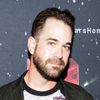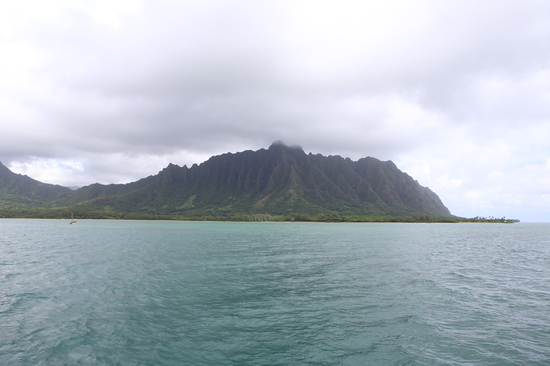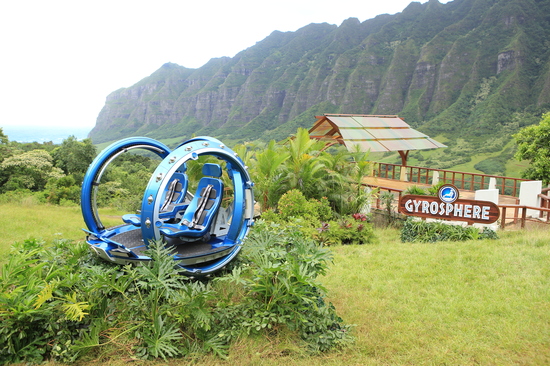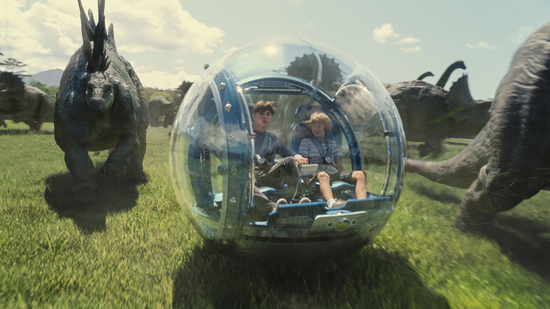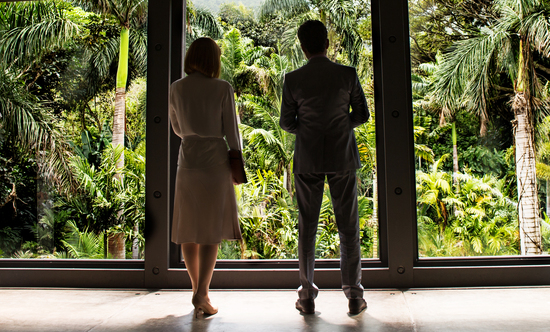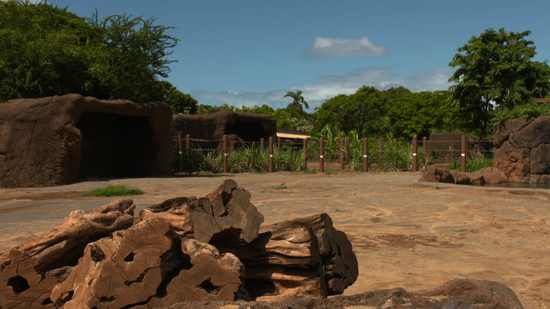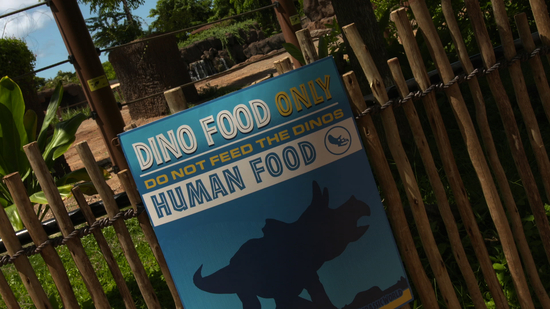Standing on sloping hills that roll down into a valley, blue skies that meet with the ocean, and massive green mountains behind me, the Kualoa Ranch in Oahu, Hawaii, feels like unspoiled paradise straight out a prehistoric era. And I swear I heard a dinosaur moaning.
Ok, maybe it wasn't a dinosaur, but a very frisky cow, or a smoke monster -- but probably a dinosaur. After all, I was standing next to a Gyrosphere and its landing platform, a set used in the highest grossing movie of the year (and third highest grossing movie of all time) Jurassic World. So a dinosaur makes complete sense.
Standing in for Isla Nublar -- the fictional island off Costa Rica, and home to the dino theme parks - the Hawaiian Islands Oahu, Maui, and Kauai (as well as New Orleans) served as shooting locations for Jurassic World, which heads to DVD/Blu-ray today, Oct. 20.
And in the video above, I take a tour of the island and talk to some key people involved the Hawaiian production of the movie.
Jess Cole, production coordinator for Jurassic World, said she was the first person on the ground from the film's production, and the last to close up. She said director Colin Trevorrow paid a lot of attention to Hawaii, and was pursuing natural elements such as vegetation and wildlife to pull into the film. The result is a paradise setting; lush, green, and ancient, and a believable location for dinosaurs to inhabit.
Taking center stage in the Hawaiian shoots is Kualoa, an operating cattle ranch, tourist destination, and favorite location for film and TV shoots. Known as Hollywood's "Hawaii Backlot," the 4,000-acre ranch is a sixth-generation owned business, and has hosted shoots such as Lost, Godzilla, and the original Jurassic Park, among others. For Jurassic World, it served as the location for the impressive Indominus Rex paddock, Chris Pratt's character's bungalow, the old and new Jurassic park gates, and the aforementioned Gyrosphere set.
In the film, the Gyrosphere is a large, self-driving vehicle encased in glass for park attendees to roam around in, and explore the extinct beasts brought back to life. It is part of a major set piece as Ty Simpkins and Nick Robinson, who play brothers Gray and Zach, go off-road and encounter a toothy threat. But what's fascinating about the landing pad built in Hawaii, and still standing, is that the surrounding truly showcase Kualoa's "from the steep mountain cliffs to the sparkling sea" environs.
By comparison, the I.Rex paddock, designed to contain the brand-new genetically created monster of Jurassic World, was built in a patch of jungle in Kualoa. What is currently standing is a pen with 40-walls and steel columns. The JW production had to dig trenches, and lay a foundation as the area was slightly below the water table. From a design standpoint, the paddock is intimidating. Electric shock warning signs, emblazoned with dinosaurs, line the "electrified" area. There are deep scratches from the I. Rex, who is trying to learn how to escape in the movie. Additionally, a glass viewing booth overlooks the pen, from where Bryce Dallas Howard's character could observe the beast her company had created. Since production has wrapped, the paddock will serve as a stop on a film tour through the ranch, beginning 2016.
According to John Morgan, president of the ranch, Kualoa has a long relationship with the Jurassic franchise following the devastation of Hurricane Iniki in 1992. The storm took a toll on the island of Kauai as director Steven Spielberg prepped final on-location shoots for the film. When he was flying over Oahu, he spotted the ranch, and selected it for the shoot. The scene they shot was when Alan Grant (Sam Neill) was running in the field with the children, away from the Gallimimus-eating T. rex. The log they hid behind, or one that resembles it, serves as a photo op on a tour that can be taken on horseback or on an ATV.
Another noteworthy Jurassic World shooting location in Hawaii is the Honolulu Zoo. About an hour's drive from the remote Kualoa Ranch, the zoo is in the comparatively bustling capital city. But it was still converted into a location on Isla Nublar. Through a little movie magic, the elephant enclosure was transformed into a dino petting zoo.
Dr. Baird Fleming, director of the zoo, said location scouts were being cagey when they first approached him about shooting there. But when he showed them the open spaces, giant metal enclosure, and large cables, he said he thinks they fell in love with it. The elephants were replaced for what would become a different type of gentle giant: men in gray mo-cap suits with saddles on, and children riding them around. Those were transformed into smaller dinos. Meanwhile, a lot of Jurassic World theme park signage went up are the area, as did "Don't feed the dinos" warnings, and dinosaur food vending stations.
For the moment when things go wrong at the park - and they always do - Fleming said the production crew used turbine fans on a platform, and blasted the ground to simulate the flapping wings of attacking Pteranodons. He said chaos was also unleashed in the form of lots of running and screaming tourists.
Things did not go so well in the movie for those extras posing as tourists, but the elephants of the Honolulu Zoo benefited from the Jurassic havoc; Fleming said all the money they made from the shoot went straight back to improving the enclosure.
Onscreen, it is never a good idea to toy with science, bring back extinct dinosaurs, and load them into a theme park with a lot of tasty humans. Watching it all go so very wrong is the appeal of the Jurassic Park franchise.
But things going wrong yet again led to a lot of right things for Hawaii in the form of multiple location shoots for Jurassic World. And, like an impact tremor in a cup of water, the ripple effect of the movie's success continues as all these sets are available to visit.
Check out the video above to get even more of an inside look at the Hawaii locations of Jurassic World, and learn more about how the movie impacted the area.
